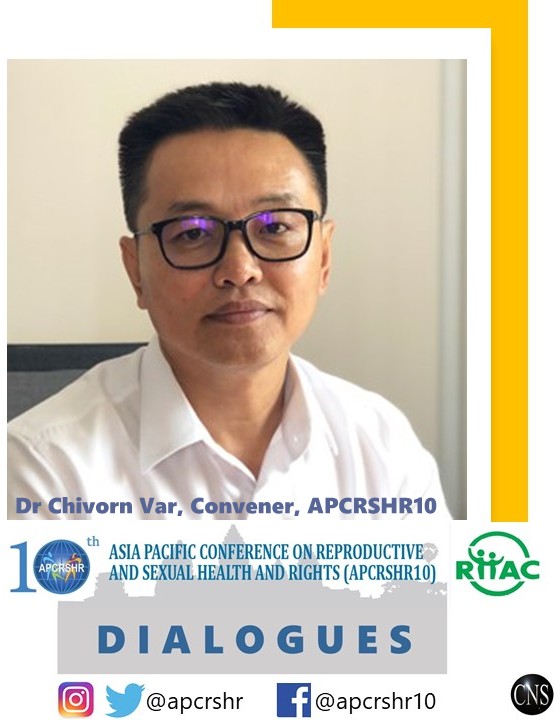" Video interview is online at: https://www.youtube.com/watch?v=07pErrBTCbw&t=10s

Dr Chivorn Var, convener of #APCRSHR10 and Executive Director of Reproductive Health Association of Cambodia
(Image by CNS (Citizen News Service citizen-news.org)) Details DMCA
Improvements in the health sector, as well as in other sectors such as infrastructure development, economic growth and poverty reduction, play a major role in improving not only health and life expectancy of the people, but also have a direct impact on their sexual and reproductive health.
Recognizing the importance of integrated sustainable development, 193 countries committed to deliver on the promise of Sustainable Development Goals (SDGs) where no-one-is-left-behind. With only less than 131 months left to deliver on 2030-SDGs, a reality check is key to ensure the world delivers on all targets, for everyone, everywhere.
"Sexual and reproductive health and rights (SRHR), as envisioned in the SDGs, are about universal access to sexual and reproductive health services, addressing issues related to gender, comprehensive sexuality education and maternal mortality, and integration of reproductive health into national strategies and programmes" said Dr Chivorn Var, convener of forthcoming 10th Asia Pacific Conference on Reproductive and Sexual Health and Rights (APCRSHR10, www.apcrshr10cambodia.org) and Executive Director of Reproductive Health Association of Cambodia (RHAC).
Progress has happened but is it fast enough?
Over the years, the overall health status of the Cambodian people has improved through expansion of medical facilities, as well as social health protection system. In the last five years, Cambodia has added nearly 100 new health centres and 30 hospitals. This has resulted in increased accessibility to healthcare services, including those for sexual and reproductive health needs. The maternal mortality ratio (MMR) has declined from 470 deaths per 100,000 live births in 2005 to 160 in 2017 (SDG target for 2030 is to reduce MMR to 70). Cambodia has also made advances in terms of the number of skilled birth attendants, institutional births, and over 90% coverage of women for receiving post-natal care within 2 days of giving birth.
With less than 11 months to achieve 90-90-90 targets for HIV, Cambodia is one of the seven countries in the world to have already achieved them. 90-90-90 targets to be achieved by 2020 refer to ensuring 90% of people living with HIV should know their status, 90% of these should be receiving lifesaving antiretroviral therapy (ART) and 90% of those on ART should be virally suppressed. If people living with HIV are virally suppressed then risk of transmission of HIV is negligible (undetectable equals untransmittable), which indeed is a critical cog in the wheel towards ending AIDS by 2030.
Dr Chivorn informed that Cambodia is currently reviewing and developing its next five years national strategic plan for sexual and reproductive health, which aims to focus on important interventions like family planning, addressing sexual and gender-based violence through government policies/ laws, increasing youth-friendly services and improving maternal and infant mortality.
Support for comprehensive sexuality education gives hope
Dr Chivorn reflected that in 1997, HIV transmission rates were very high in Cambodia. The government used this as an entry point for educating young people and adolescents on HIV/AIDS by introducing adolescent reproductive health education. Gradually other subjects like pregnancy, sexually transmitted diseases and safe sex practices were also added. There was initial resentment from parents, but gradually the mindsets changed with the help of several workshops and training sessions organised for young people, village chiefs, local authorities and officials from ministries of education and health.
One very recent progressive step, which Cambodia's Ministry of Education took in 2019, was to endorse the inclusion of comprehensive sexuality education as a compulsory subject in the school curriculum. The Ministry of Health is now helping in the process to develop textbooks for grade 1 to grade 12. Roll out of this will begin in 2022.
Despite progress, challenges remain
One major challenge, as pointed out by Dr Chivorn Var, is paucity of funds and limited resources with many competing priorities. The problem has been further aggravated due to a cut in US government's aid for safe abortion services. This has negatively impacted the SRHR programmes of many developing countries in not only Asia Pacific but other regions as well, even as countries in the European Union continue to provide financial support to these services. So it is important to ensure that SRHR must be valued and considered when resources are mobilized and allocated.
The SRHR programmes in Cambodia, as well as in many other countries of Asia Pacific region, require increased and sustained funding in order that SRHR relevant SDGs be achieved by 2030.
Primary prevention of cervical cancer is vital
According to the World Health Organization (WHO), cervical cancer is the biggest cause of cancer-related death among women in Cambodia. An estimated 1500 women develop cervical cancer annually and 800 die because of it every year. Cervical screening programme introduced since 2013 uses the WHO recommended VIA (visual inspection with acetic acid) method as a screening tool and cryotherapy for early treatment. But due to shortage of funds it is yet to introduce the HPV (human papilloma virus) vaccine for all girls aged 9 to 14 years. Dr Chivorn hoped that, in addition to the existing screening programme, the Cambodian government will also consider introducing HPV vaccine for primary prevention.
(Note: You can view every article as one long page if you sign up as an Advocate Member, or higher).





